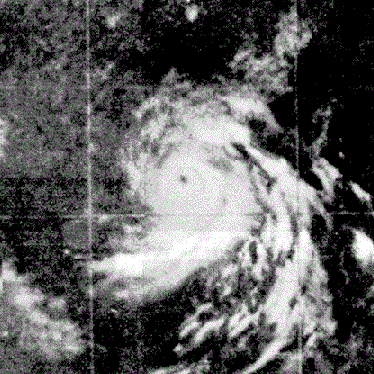1978 Pacific typhoon season
| 1978 Pacific typhoon season | |
|---|---|

Season summary map
|
|
| Seasonal boundaries | |
| First system formed | January 6, 1978 |
| Last system dissipated | December 16, 1978 |
| Strongest storm | |
| Name | Rita |
| • Maximum winds | 220 km/h (140 mph) (10-minute sustained) |
| • Lowest pressure | 878 hPa (mbar) |
| Seasonal statistics | |
| Total depressions | 34 |
| Total storms | 30 |
| Typhoons | 15 |
| Super typhoons | 1 |
| Total fatalities | Unknown |
| Total damage | Unknown |
| Related articles | |
| Severe tropical storm (JMA) | |
| Tropical storm (SSHWS) | |
| Duration | January 6 – January 13 |
|---|---|
| Peak intensity | 100 km/h (65 mph) (10-min) 970 hPa (mbar) |
| Typhoon (JMA) | |
| Category 2 typhoon (SSHWS) | |
| Duration | April 15 – April 26 |
|---|---|
| Peak intensity | 150 km/h (90 mph) (10-min) 955 hPa (mbar) |
| Tropical storm (JMA) | |
| Tropical storm (SSHWS) | |
| Duration | June 13 – June 20 |
|---|---|
| Peak intensity | 85 km/h (50 mph) (10-min) 985 hPa (mbar) |
| Tropical storm (JMA) | |
| Tropical storm (SSHWS) | |
| Duration | June 21 – June 24 |
|---|---|
| Peak intensity | 85 km/h (50 mph) (10-min) 990 hPa (mbar) |
| Tropical storm (JMA) | |
| Tropical storm (SSHWS) | |
| Duration | June 26 – June 30 |
|---|---|
| Peak intensity | 85 km/h (50 mph) (10-min) 992 hPa (mbar) |
| Typhoon (JMA) | |
| Category 1 typhoon (SSHWS) | |
| Duration | July 11 – July 23 |
|---|---|
| Peak intensity | 130 km/h (80 mph) (10-min) 965 hPa (mbar) |
| Typhoon (JMA) | |
| Category 1 typhoon (SSHWS) | |
| Duration | July 22 – August 2 |
|---|---|
| Peak intensity | 130 km/h (80 mph) (10-min) 975 hPa (mbar) |
| Typhoon (JMA) | |
| Category 1 typhoon (SSHWS) | |
| Duration | July 22 – August 3 |
|---|---|
| Peak intensity | 130 km/h (80 mph) (10-min) 960 hPa (mbar) |
| Severe tropical storm (JMA) | |
| Tropical storm (SSHWS) | |
| Duration | July 24 – July 30 |
|---|---|
| Peak intensity | 100 km/h (65 mph) (10-min) 980 hPa (mbar) |
The 1978 Pacific typhoon season has no official bounds; it ran year-round in 1978, but most tropical cyclones tend to form in the northwestern Pacific Ocean between June and December. These dates conventionally delimit the period of each year when most tropical cyclones form in the northwestern Pacific Ocean.
The scope of this article is limited to the Pacific Ocean, north of the equator and west of the international date line. Storms that form east of the date line and north of the equator are called hurricanes; see 1978 Pacific hurricane season. Tropical Storms formed in the entire west pacific basin were assigned a name by the Joint Typhoon Warning Center. Tropical depressions in this basin have the "W" suffix added to their number. Tropical depressions that enter or form in the Philippine area of responsibility are assigned a name by the Philippine Atmospheric, Geophysical and Astronomical Services Administration or PAGASA. This can often result in the same storm having two names.
33 tropical depressions formed this year in the Western Pacific, of which 29 became tropical storms. 15 storms reached typhoon intensity, of which 1 reached super typhoon strength. Many of the storms either remained at sea or failed to do any damage.
In the Philippines, Typhoon Olive (Atang) killed 3 people and left 3,500 homeless. A lengthened ex-”FS” ship of Compania Maritima was caught in it, the MV Leyte. She was wrecked in the southwestern portion of Sibuyan Island trying to reach shelter. She was then on a Manila-Cebu voyage.
Agnes formed on July 24, made a complete loop, and struck China on July 29 with winds of 55 mph after peaking at 60 mph. It dissipated the 30th. In Hong Kong Tropical Storm Agnes killed 3 people.
Irma, the eighth typhoon of the 1978 season, developed in the monsoon trough southeast of Taiwan. It made landfall in Honshu, Japan. With winds of up to 120 km/h, Typhoon Irma killed at least 6 people and made about 3,000 homeless. Four people were missing and about 100 were injured by floods and landslides in southwestern Japan. It destroyed or damaged 1,597 homes and left 6,266 homes flooded. Irma smashed windows, overturned cars, and capsized several fishing boats. Several athletes at the Japan-China Friendship Track and Field Meet in Kitakyushu were injured when a freak gust blew them ten feet in the air. A Liberian-registered tanker was swept from its moorings off the port of Kure and drifted for nearly 5 kilometers before running aground off a small island in the Inland Sea. Irma remained a typhoon for only 12 hours becoming the shortest-lived typhoon of the season.
...
Wikipedia














